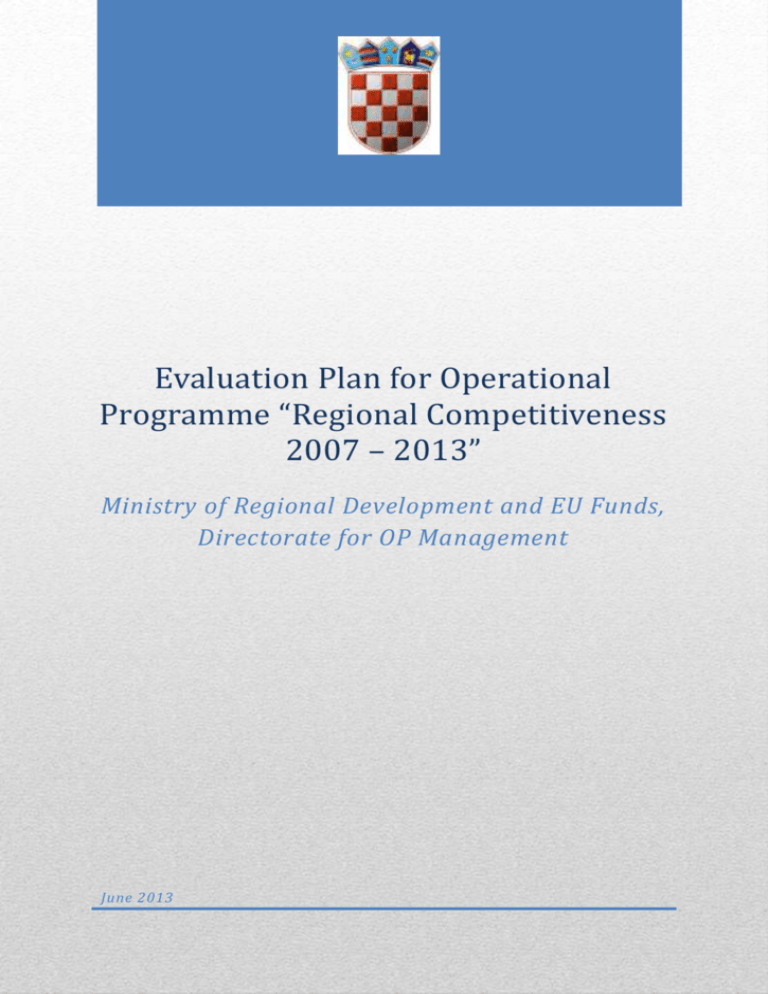Evaluation Plan for Operational Programme
advertisement

Evaluation Plan for Operational Programme “Regional Competitiveness 2007 – 2013” Ministry of Regional Development and EU Funds, Directorate for OP Management June 2013 Table of Contents 1. Introduction................................................................................................................................................................2 2. Organizational structure .......................................................................................................................................3 2.1 Evaluation plan Manager ..................................................................................................................................3 2.2. Evaluation Steering Group (ESG) ..................................................................................................................4 3. Planned Evaluation Activities .................................................................................................................................4 3.1. Evaluation types and questions ......................................................................................................................5 3.1.1. Ex-ante evaluation of the ERDF/CF OP 2014 - 2020 .....................................................................5 3.1.2. Evaluation of the performance of the project pipeline. ................................................................6 3.1.3. Evaluation of the effectiveness and efficiency of the Grant Schemes .....................................6 3.1.4.Priority-related evaluations (focusing on a particular priority of the OP)............................7 3.1.5.Horizontal evaluation questions that will be assessed per each priority axes ....................8 3.2. Indicative timetable .............................................................................................................................................9 3.3. Indicative resources required .........................................................................................................................9 4. Dissemination of evaluation reports .....................................................................................................................9 1 1. Introduction The present Evaluation Plan for Operational Programme “Regional competitiveness 2007 – 2013” has been drafted in response to the obligations contained / requirements stipulated in the European Council (EC) Regulation 1083/20061 that, stipulates: “Member States shall provide the resources necessary for carrying out evaluations, organize the production and gathering of the necessary data and use the various types of information provided by the monitoring system. Member states may also draw up, where appropriate an evaluation plan presenting the indicative evaluation activities which they intend to carry out in the different phases of the implementation”. The Regulation also identifies three types of evaluation according to their timing: before (exante), during (ongoing/interim) and after (ex-post) the implementation period. This concept served as a basis for drafting this Plan, while the specific formats and contents have been modeled based on the guidance document of the European Commission regarding evaluation activities2. Drafting of the Evaluation plan was based on the following national legal acts: Treaty concerning the accession of the Republic of Croatia to the European Union (OG, International Agreements, No. 2/2012) (the Accession Treaty); Act on the Establishment of Institutional Framework for the Use of European Union Structural Instruments in the Republic of Croatia (OG No. 78/12); Decree on the Bodies of the Management and Control System for the Use of European Union Structural Instruments in the Republic of Croatia, (OG No. 97/2012) (the Decree); Common National Rules, in particular Rule no. 16, Programme Evaluation and Closure; and Evaluation Strategy for European Structural Instruments, adopted by the Croatian Government on 29 March 2012. The main purpose of this document is to provide an overall framework for the evaluation activities before, during and after implementation of the OP Regional Competitiveness. The overall objective is to use the evaluation data as a management tool during the implementation of the RCOP, but the lessons learned will also be valuable for the future programming activities. This document presents the organizational structure suggested for successful implementation of the evaluation activities. It also outlines the scope, methodology, the timeframe and required resources for the proposed evaluations. Lastly, it briefly proposes the dissemination of evaluation findings. Council Regulation (EC) No 1083/2006 of 11 July 2006 laying down general provisions on the European Regional Development Fund, the European Social Fund and the Cohesion Fund and repealing Regulation (EC) No 1260/1999, art. 48.1 http://ec.europa.eu/regional_policy/sources/docoffic/official/regulation/pdf/2007/general/ce_1083(2006)_en.pdf 2 Working Document No.5: “The New Programming Period 2007-2013 - Indicative guidelines on evaluation methods: evaluation during the programming period”, issued on April 2007 (Working Document)2, available at http://ec.europa.eu/regional_policy/sources/docoffic/2007/working/wd5_ongoing_en.pdf. 1 2 2. Organizational structure The evaluation plan is a complex document, entailing several tasks and activities and envisaging a number of outputs each requiring specific processes leading to the final product, therefore, it needs to be properly managed and coordinated. The responsible persons for organization and implementation of evaluation activities are the Evaluation Plan Manager, and the members of the Evaluation Steering Group. 2.1 Evaluation Plan Manager In accordance with the national Evaluation Strategy3 and with recommendations from EU guidance documents, the Managing Authority of the Regional competitiveness Operational Programme (OP RC) - Ministry of Regional Development of EU Funds has appointed a Manager of the evaluation plan to perform the evaluation function within its Directorate for the Management of Operational Programmes. The Manager of the Evaluation Plan has the following main functions: Coordinates drafting of the Evaluation Plan; Determines the purpose and users of evaluation results Organizes and runs partnership activities needed to identify evaluation questions themes; Drafts TOR for commissioning /procuring evaluation services; Identifies the mix of skills and experiences required in the evaluation team Ensures that background documentation/materials compiled are submitted to the evaluator(s) Organizes the relationship between evaluators and the Evaluation Steering Groups (ESG); Follows the progress of the evaluation; provides feedback and guidance to the evaluator(s) throughout all phases of implementation Promotes the implementation of the EP; In cooperation with the ESG assesses the quality of the evaluation report(s) and discusses strengths and limitations with the evaluator(s) to ensure that the draft report satisfies the ToR, and that evaluation findings are defensible and recommendations are realistic Periodical updates and / or integration of the Plan; and 3 http://www.mrrfeu.hr/UserDocsImages/EU%20fondovi/Vrednovanje%20vezani%20dokumenti/Evaluation%20Strategy%20for%20European%20Structural%20Instrument_%20eng_f inal.pdf 3 Disseminates evaluation results. Promotes the implementation of recommendations and use of evaluation results in present and future programming. 2.2. Evaluation Steering Group (ESG) In compliance with the Evaluation strategy for EU Structural instruments, Rule 16 “Programme evaluation and closure” and internal MoP, MA will establish the Evaluation Steering Group. Members of the Group will be appointed by IB1 and will be the main focal point where coordination of management of the EP for the OP RC will take place. The Evaluation Steering Group will act as the coordinator of the evaluation activities at the OP level, the catalyst of the professional development of the evaluation experts, and the proponent of/supporting structure for the initiatives to increase evaluation culture in Croatia, while monitoring the state of progress in achieving the objectives of the Op RC and Evaluation Strategy. Members of the group will be take part in all stages of the evaluation process. They will have the role of “guiding and monitoring the evaluation process”. A list of their responsibilities includes: initiating a specific evaluation in accordance with the evaluation plan; promoting (and contributing to) the elicitation and fine tuning of the evaluation questions; developing the terms of reference for external as well as internal evaluators; identifying and managing any risks associated with the evaluation process; providing relevant information or advice which may be used by the evaluators; ensuring interactions with the evaluators on the methodology adopted, defining quality standards for evaluation, and ensuring overall quality of the evaluation process and products; ensuring, where necessary, that the Evaluation Plan is updated; receiving, discussing, and proposing for acceptance the evaluation reports presented by the evaluators; and ensuring the adequate dissemination and use of evaluation results. The Managing Authority may appoint external experts to support the work of the ESG, or invite external experts to selected meetings. 3. Planned Evaluation Activities Managing Authority is going to use external evaluation expertise through several contracts as per the timetable presented in the indicative list of evaluations to be carried out (see Annex 1 below, The list of planned evaluations). The decision on the methodology of conducting the evaluations considers the limited timeframe of the OP implementation, which is also dependent on the dynamics of the procurement processes. The internal evaluation personnel of the MA and IB1 bodies will take an active part in planned evaluations (e.g. attend the project meetings and comment on drafts of outputs). Furthermore, they will be fully responsible for the provision supporting documents, contacts and data. In 4 addition to formal training, such involvement is expected to improve the understanding of evaluation principles under the Structural and Cohesion Funds, which will further strengthen the internal capacities of the involved bodies. 3.1. Evaluation types and questions Managing Authority, based on the decision brought by the Evaluation Steering Group at the meeting held on 10 June 2013, plans to conduct following evaluations: 1. Ex-ante evaluation of the ERDF/CF OP 2014 - 2020 2. Evaluation of the performance of the project pipeline. 3. Evaluation of the effectiveness and efficiency of the Grant Schemes 4. Priority-related evaluations (focusing on a particular priority of the OP) More specifically, the planned evaluations should provide detailed answers and assessment of the following questions: 3.1.1. Ex-ante evaluation of the ERDF/CF OP 2014 - 2020 1. Are the selected thematic objectives, the investment priorities and corresponding objectives of the OP consistent with the Common Strategic Framework, the Partnership Contract, the country specific recommendations under art. 121(2) of the Treaty and the Council recommendations adopted under art. 148(4) of the Treaty? 2. Are the identified national and regional challenges and needs in line with the Europe 2020 Strategy objectives and targets, the Council Country specific recommendations and the National Reform Plan? 3. Do the investment priorities and their specific objectives consistently reflect these challenges and needs? 4. Have the key territorial challenges for urban, rural, coastal and fisheries areas, as for areas with particular territorial features been analyzed and duly taken into account in the OP strategy? 5. Does the OP take into account the influence of other policies and programmes (including other CSF programmes) on the expected results of the OP? 6. Are the planned measures to promote equal opportunities and sustainable development, respectively, adequate? 7. Are the defined indicators and the overall monitoring system quality and reliable? 8. Are the proposed programme specific indicators relevant and clear? 9. Are the quantified target values for indicators realistic, taking into consideration the financial allocations to priority axes and indicative allocations at the level of categories of intervention/investment priorities? 10. Are the milestones selected for the performance framework adequate? 11. Are the human resources and administrative capacity for management of the OP adequate? 12. Are the procedures for monitoring and collecting the necessary data to carry out evaluations adequate? 13. Is there overall consistency and adequacy of financial allocations? 5 3.1.2. Evaluation of the performance of the project pipeline. Does the project pipeline deliver good quality and fundable projects in the quantity necessary for good absorption of the funds? Has maturity of projects been assessed and have projects been prioritized regarding to the level of it? Is the pipeline operating in a transparent, fair and efficient way? Has institutional and financial sustainability of projects listed in pipeline been analyzed? Have project been prioritized regarding to their potential benefits/impacts? Is the risk assessment of each mature projects listed in pipeline performed? Have projects resource and co-financing demands been analyzed? Is the pipeline stable enough to serve the needs in longer term, for upcoming programmes, too? Evaluation of the implementation of horizontal principles How and to what extent principles the following principles expected to/are incorporated in the listed projects: o Environmental sustainability, with focus on BRI and culture/tourism related infrastructure, o Gender equality ,with focus on the SME schemes To what extent the selection criteria and the monitoring systems and procedures support the implementation of these principles? How project selection support regional development objectives, mainly the catching up of the lagging behind regions? How embedded these projects are to “official” development strategies and the plans, ambitions and strategies of main local stakeholders? 3.1.3. Evaluation of the effectiveness and efficiency of the Grant Schemes To what extent the selection criteria and mechanisms applied in the various (all) Grant Schemes are conducive to projects that are in line with the objectives of the programme (in all priorities)? To what extent human and institutional capacities are available at both the implementing institutions (IBs and MA) and at the Beneficiaries’ organizations? How economically have the utilized human and institutional capacities been transferred into the expected impacts? Which are the unexpected impacts that have resulted from the implementation of Grant Schemes? What are the major obstacles of better performance in terms of improving the speed, transparency and effectiveness of the management of the programmes? To what extent procedures applied within the management system and requirements demanded from the Beneficiaries shall be streamlined and simplified in order to increase the efficiency of the schemes? 6 To what extent can positive impacts resulting from the implementation of each Grant Scheme insure durability and sustainability? To what extent are current practices and procedures transferable to the next programmes? Horizontal evaluation questions that will be assessed per Grant Scheme Job creating effect How many new jobs are expected to be created on the basis of the project proposals? What are the lessons/evidence that link interventions by each Grant Scheme to job creation in different circumstances? What are the employment effects from improved access to infrastructure (e.g. not just direct jobs created, but those in other sectors affected by better access to roads, more reliable power, etc.)? What are the effects of vocational training and improved skills provided through Grant Schemes implementation on jobs? What are the possible side-effects: substitution effects (supporting jobs that would have been created without support) or displacement effects (supporting jobs that are not additional) and what are the chances of these jobs being sustainable? What are the major factors that drive job creation and how these factors influence the jobs created in the different priorities of the OP? Evaluation of the implementation of horizontal principles How and to what extent principles the following principles expected to/are incorporated in the listed projects: o Environmental sustainability, with focus on BRI and culture/tourism related infrastructure, o Gender equality ,with focus on the SME schemes To what extent the selection criteria and the monitoring systems and procedures support the implementation of these principles? How project selection support regional development objectives, mainly the catching up of the lagging behind regions? How embedded these projects are to “official” development strategies and the plans, ambitions and strategies of main local stakeholders? 3.1.4. Priority-related evaluations (focusing on a particular priority of the OP) Expected impacts of “Business-related infrastructure” priority How infrastructure development contributes to the performance of the local economy, and to the socio-economic situation in region? 7 To what extent new facilities are used? To what extent productivity is higher in the new facilities? What added value is provided for the investors and other stakeholders by the new facilities? What are the chances of economic and institutional sustainability of the new facilities? How new facilities contributed to increased FDI and the expansion of or increase the number of SMEs? How new/improved tourism facilities contributed to development of off-seasonal and inland tourism? How new/improved culture facilities contributed to development of off-seasonal and inland tourism? How new/improved tourism facilities influenced on the number of tourist-nights in the municipality/county? How new/improved culture facilities influenced on the number of tourist-nights in the municipality/county? Expected impact of “Research and development” related operations How the selected projects contribute to the commercialization of research results of the public sector institutions? To what extent the need for new infrastructure becomes justified by occupation of the infrastructure by new activities? Expected impact of the programme on SMEs What is the identifiable added value of the support in terms of increased productivity, better export-capacities, innovation, new products? What is the identifiable added value of the support for tourism-related SMEs, e.g. extended season? To what extent the scheme enhanced entrepreneurship, in general (such as number of SME’s, number of new or young entrepreneurs, the society’s attitude to entrepreneurship)? 3.1.5. Horizontal evaluation questions that will be assessed per each priority axes Job creating effect of the various priorities How many new jobs are expected to be created on the basis of the project proposals? What are the possible side-effects: substitution effects (supporting jobs that would have been created without support) or displacement effects (supporting jobs that are not additional) and what are the chances of these jobs being sustainable? 8 What are the major factors that drive job creation and how these factors influence the jobs created in the different priorities of the OP? Evaluation of the implementation of horizontal principles 3.2. How and to what extent principles the following principles expected to/are incorporated in the listed projects: o Environmental sustainability, with focus on BRI and culture/tourism related infrastructure, o Gender equality , with focus on the SME schemes To what extent the selection criteria and the monitoring systems and procedures support the implementation of these principles? How project selection support regional development objectives, mainly the catching up of the lagging behind regions? How embedded these projects are to “official” development strategies and the plans, ambitions and strategies of main local stakeholders? Indicative timetable The evaluation activities are planned to take place between the end of 2013 and end of 2017. Annex 1, The list of planned evaluations, explains in detail the expected delivery dates of final evaluations reports, as well as the training activities. 3.3. Indicative resources required Financial resources. The total indicative budget for the planned evaluations is Euro 740.000. The majority of evaluations will be financed by the Technical Assistance Priority of the RCOP (Euro 740,000), while ex ante evaluation of ERDF/CF OP 2014-2020 is to be financed from IPA TAIB 2011. Human resources. The Managing Authority and IB1 will take into consideration the human resources required for the management of the evaluation contracts, as well as activities related to management of individual evaluations (including providing access to relevant data, providing information on relevant sector policies and projects, as well as generating feedback of stakeholders and providing them accordingly to the evaluators). Furthermore, it should be noted that the outcomes of the evaluation analyses should be properly disseminated to all relevant stakeholders, which will be primarily organized by EP Manager. 4. Dissemination of evaluation reports In principle, all evaluation activities and reports should be given the maximum of external visibility. Upon initiating each evaluating activity, the EP manager will propose to the ESG the most appropriate mode of information dissemination. He/she will also propose specific approaches to reach particular stakeholder target groups. The OP Monitoring Committee will be regularly updated on the evaluation activities. Furthermore, the communication tools and plans will be coordinated with the other relevant documents (e.g. OP Communication plan). The communication tools may include (not limited 9 to); online publications, newsletter feature articles, press releases and presentations in public events. The table below provides a synoptic view of the provisional main communication targets of each evaluation proposed in the Annex 1. The list of planned evaluations; Scope of evaluation Evaluation of the performance of the project pipeline + horizontal issues Evaluation of the effectiveness and the efficiency of the Grant Schemes + job-creating effect + horizontal issues Priority-related evaluations BRI R&D SME + job-creating effect Main Target Groups for Dissemination modalities of Dissemination the results MA IBs and implementing structures ESG OP’s Stakeholders MC General Public Publication of full report and executive summary on OP website Information by mailing list (with link to webpage) to interested internal structures Newsletter (main findings + link to report) Report to MC MA IBs and implementing structures ESG OP’s Stakeholders MC General Public Publication of full report and executive summary on OP website Information by mailing list (with link to webpage) to interested parties Newsletter (main findings + link to report) Report to MC MA IBs and implementing structures ESG OP’s Stakeholders MC General Public Publication of full report and executive summary on OP website Information by mailing list (with link to webpage) to interested parties Newsletter (main findings + link to report) Report to MC + horizontal issues 10 Annex 1. The list of planned evaluations Type of the evaluation Scope of the evaluation Strategic, initial Ex-ante evaluation Operational, interim Evaluation of the performance of the project pipeline + horizontal issues Operational, Interim Operational, Interim Strategic, final Evaluation of the effectiveness and the efficiency of the Grant Schemes + job-creating effect + horizontal issues Priority-related evaluations BRI R&D SME + job-creating effect + horizontal issues Ex-post evaluation of the RCOP 2007-2013 Duration of the evaluation 6 months Timing of the final products Benchmarks and evaluation quality standards, under ESG supervision EUR 298,000 (source of financing: IPA TAIB 2011) Final evaluation report: Q1/2014 EC ESG Management Structures OP website Benchmarks and evaluation quality standards, under ESG supervision EUR 150,000 Final evaluation report: Q4 2014 Benchmarks and evaluation quality standards, under ESG supervision EUR 200,000 EC ESG Management Structures OP website Short seminars EC ESG Management Structures OP website Benchmarks and evaluation quality standards, under ESG supervision EUR 390,000 Methodology External External + 2 months for reporting 6 months Indicative budget Source External + 2 months for reporting 6 months + 2 months for reporting External TBA External TO BE PERFORMED BY EC Built-in trainings: Q3 2014 Seminars: Q2 2014 Final evaluation report: Q3 2015 Built-in trainings: Q1-Q2 2015 (EUR 130,000 per priority) TO BE FUNDED FROM EC TA Final evaluation report: Q2 2016 Seminars: Q2 2016 Final evaluation report: Q4 2015 Results dissemination EC ESG Management Structures OP website Short seminars EC ESG Management Structures OP website 11 12








